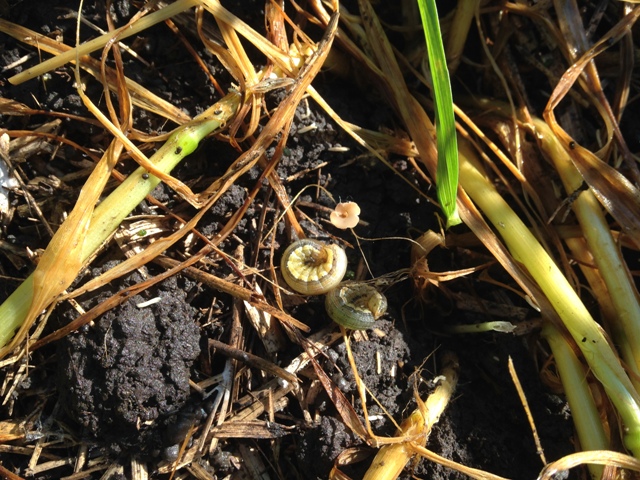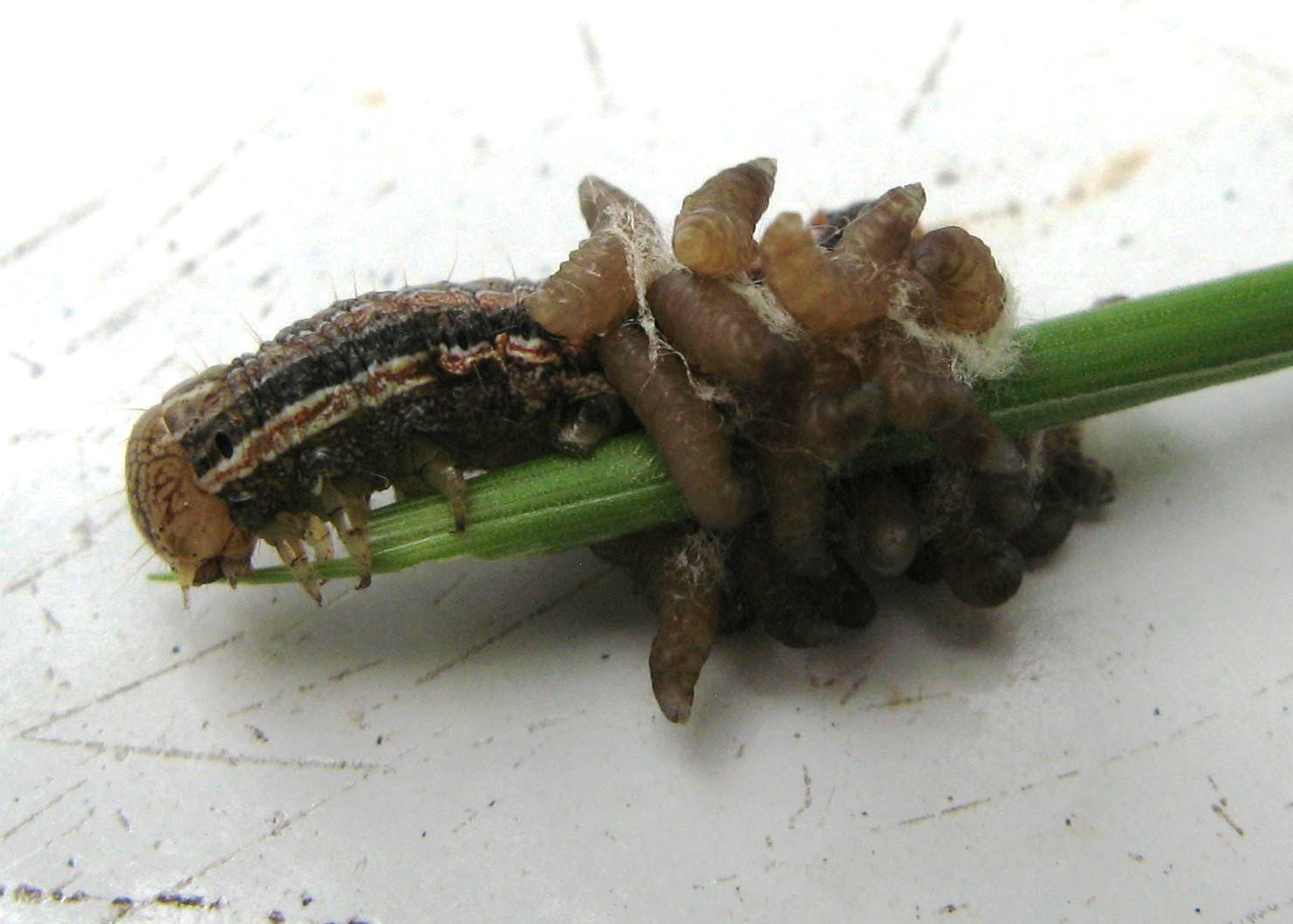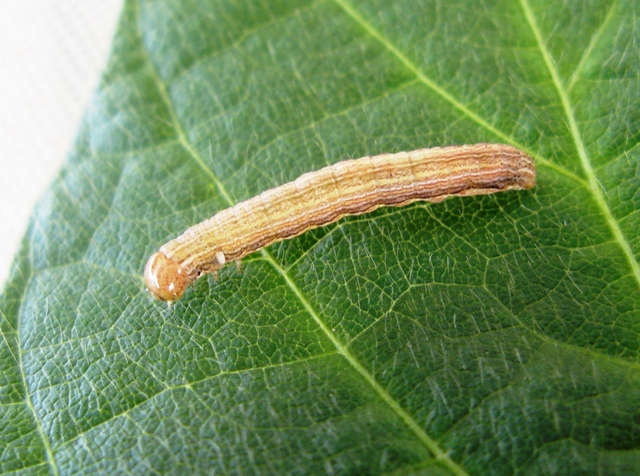Manitoba Insect & Disease Update: July 7, 2015
Summary
Some localized higher populations of armyworms and grasshoppers are present. So scouting is encouraged, although in many cases populations are noticeable but not economical.
Cereal Crops
Armyworms: Armyworms are present in noticeable levels in many areas of Central Manitoba. Larvae can be scouted for by counting the number of larvae per square foot on average. The majority of larvae will be on the ground during the day and often hidden under debris on the soil, under clumps of soil or in crack in soil, so scout the ground thoroughly. Many will curl up when disturbed. The colour of the larvae can sometimes vary considerably between individuals.
Cereal crops can tolerate considerable defoliation from armyworm, and the threshold suggested in cereal crops is 4 or more armyworms per square foot on average. Populations can be very patchy in a field.

Figure 1. Armyworms. Photo by Tao Wang - Cargill AgHorizons
A MAFRD factsheet on armyworms, explaining thresholds and scouting, has been recently revised and is available at: http://www.gov.mb.ca/agriculture/crops/insects/true-armyworm.html
Armyworms are often heavily parasitized. Figure 1 below is an armyworm from a field south of Carman with multiple larvae of a parasitic wasp emerging from it. Figure 2 is of an armyworm with the egg of a parasitic fly behind the head.


Fig. 2. Larvae of parasitic wasp emerging from armyworm. Fig. 3. Egg of parasitic fly on armyworm
Wheat Midge: A reminder that wheat is only susceptible to wheat midge from the time the heads emerge until flowering starts (when anthers are produced). The wheat kernels change once the wheat flowers, and the wheat kernels are no longer an acceptable food for the larvae of wheat midge. A lot of the wheat is Manitoba has anthers now, so does not need to be assessed for levels of adult wheat midge. It will just be the very late seeded fields that may still be at potentially susceptible stages. Emergence of wheat midge is likely still in the early stages in most areas, so most of the wheat would have escaped potential feeding from wheat midge by progressing past susceptible stages before wheat midge populations peak. No high levels of wheat midge have been reported so far.
Canola
Root Maggots: Currently there are low levels of most of the potential pest insects in canola. Some have been noting root maggots on some of the roots, however. Foliar insecticides and seed treatments will not work at managing root maggots, so if higher levels are noted in some fields, take note of this and consider some of the cultural controls that may help manage root maggots for future canola crops.
If practical, adjusting seeding rates and row spacing can be used to minimize root maggot feeding in canola. Increased seeding rates and increased row spacing (to about 25 to 30 cm) can reduce damage to the roots by root maggots (Canadian Journal of Plant Science. 1998. 671-681). Tighter crop rotations may also lead to increased root maggot feeding (Journal of Economic Entomology. 2012. 1261-1267). So getting away from tighter canola rotation may help reduce damage from root maggots.
So if on your farm, or your clients farm, the trend has been towards tighter canola rotations and lower seeding rates, one of the factors to consider when selecting rotations and seeding rates is whether root maggots seem to be increasing in these fields and whether some of these cultural controls should be considered to try and mange levels.
Insect Monitoring Programs
Bertha Armyworm: Pheromone-baited traps are used to monitor adult moths of bertha armyworm, and forecast areas that potentially could have higher levels of larvae later in the summer. Traps were set up in early-June, and currently only levels suggesting low risk of damage form the larvae have been detected. Anything under a cumulative count of 300 moths in the trapping period is considered lower risk. Once counts get over 300 risk moves into an unpredictable risk zone, and much higher counts are needed to be in moderate and high risk categories. The highest count currently in Manitoba is 173 moths. Cumulative counts will increase over the next couple of weeks, so it remains to be seen whether any counts move above the low risk category.
Table 1. Highest Cumulative Counts of Adult Moths of Bertha Armyworm in Manitoba as of July 7, 2015
| Location | Region | Trap Count |
|---|---|---|
| Alexander | Southwest | 173 |
| Douglas | Southwest | 136 |
| Darlingford | Pembina | 94 |
| Roseland | Southwest | 67 |
| Glenboro | Pembina | 49 |
| Carberry | Central Plains | 46 |
| Benito | Valleys North | 37 |
Compiled by:
John Gavloski, Entomologist
Manitoba Agriculture, Food and Rural Development
Phone: (204) 745-5668 Fax: (204) 745-5690.
To report observations on insects or plant pathogens that may be of interest or importance to farmers and agronomists in Manitoba, please send messages to the above contact address.
To be placed on an E-mail list so you will be notified immediately when new Manitoba Insect and Disease Updates are posted, please contact John Gavloski at the address or numbers listed above.
Manitoba Insect & Disease Update: July 7, 2015
John Gavloski, Entomologist
Manitoba Agriculture, Food and Rural Development
Phone: (204) 745-5668 Fax: (204) 745-5690.
To report observations on insects or plant pathogens that may be of interest or importance to farmers and agronomists in Manitoba, please send messages to the above contact address.
To be placed on an E-mail list so you will be notified immediately when new Manitoba Insect and Disease Updates are posted, please contact John Gavloski at the address or numbers listed above.
Manitoba Insect & Disease Update: July 7, 2015

